mobile View, to the German Version tap the flag


- possession of France
- overseas department, ultraperipheral part of France and the EU
- own name: Département et région d'outre-mer de la Réunion
- old name: Île Bourbon
• Flags
• unofficial Flags
• historical Flags
• Meaning/Origin of the Flag
• Coat of Arms
• Meaning/Origin of the Coat of Arms
• Map
• Numbers and Facts
• History
• Îles Éparses
• Origin of the Country's Name
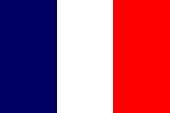
Flag of France,
ratio = 2:3,
Source, by: Corel Draw 4,
FOTW





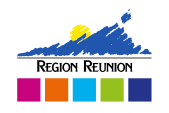
Flag of the Regional Council,
ratio = 2:3,
Source, by:
FOTW,
World Statesmen



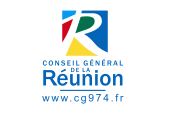
Flag of the General Council,
ratio = 2:3,
Source, by:
FOTW



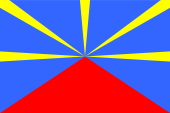
since 2013,
partial official cultural Flag (PRG),
ratio = 2:3,
Source, by:
FOTW,
Wikipedia (FR)






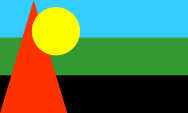
since 1984,
unofficial cultural Flag (MLK),
ratio = 3:5,
Source, by:
Wikipedia (FR),
Mouvman lantant koudmin,
vector by Carport, Public domain, via Wikimedia Commons



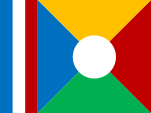
since 1996,
unofficial cultural Flag (APDR),
ratio = 3:4,
Source, by:
FOTW,
Wikipedia (FR),
Ch1902,
Public domain, via Wikimedia Commons





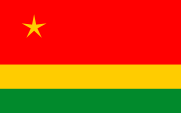
since 2008,
Independence flag of the LPLP,
ratio = 5:8,
Source, by:
Wikipedia (FR), Ch1902,
Public domain, via Wikimedia Commons





2003-2013,
unofficial cultural Flag (PRG),
ratio = 2:3,
Source, by:
FOTW,
Wikipedia (FR)





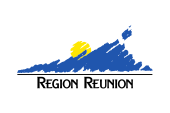
1990-2015,
Flag of the Regional Council,
ratio = 2:3,
Source, by:
FOTW



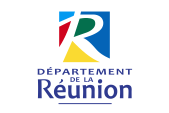
to 2015,
Flag of the Department,
ratio = 2:3,
Source, by:
FOTW,
World Statesmen




All French colonies had no own flag over a long period. It had to be hoisted the French tricolor. This in principle usual until today. The status of the colonies changed over the years. Some of them are now overseas departments, and thus a ultraperipheric part of France and of the EU; others are overseas communities, autonomous, and not a part of France or the EU. Overseas departments belong – in contrast to the departments of the motherland – to no administrative region of France, they are a separate region. The territorial entity has therefore officially to use the flag of France. However, the General Council as the highest elected collegial body of a French Department and the Regional Council as the highest elected collegial body of a French Region can have their own flags. These flags of departments and regions, however, have oftenly the appearance of company flags with logos or even stylized images, appear carelessly, ahistorical, technocratic and modernist, because in the strictly centralist France is avoided any regionalism or even a historical subscription. Because of that these logo flags of regions are unpopular and are rarely used.
Réunion does not actually have an unofficial flag, at least not one that has become established as a distinctive sign. There are only several proposals from parties and groups that are also partly striving for independence. which are used as flags. Already in 1984, the MLK (Mouvman Lantant Koudmin Association) proposed a flag. It shows three horizontal stripes in light blue (sky, sea), green (vegetation, hope, freedom) and black (slavery). At the mast rises a red triangle (volcanism) with a yellow disc (sun). The five colours are also meant to indicate the origin of the island's population from all five continents of the earth.
The LPLP (Lorganizasyon popilèr po libèr nout peï) proposed a flag in 1986 that showed three horizontal stripes in red (slavery), yellow and green (freedom). The broadened red stripe shows a five-pointed yellow star in the upper corner, which is supposed to stand for five peoples living on the island: Kaf, Yab, Malbar, Zarab and Shinwa. This flag was recognised in 2008 as the flag for a possibly independent Réunion. The combination of the colours green, yellow and red is called the Panafrican Colours: Perhaps in 1900 was the beginning of the Panafrica-Movement, wich wants to emphasize the commons of all people with black skin. The colour-triad green-yellow-red, wich is used by many african and even american countries in their flags after the independence, stands for the political unity of Africa, of all black people. The first country was Ghana in 1957. As the origin apply the colours of Ethiopia (Abessinia), the oldest independent state in Africa.
In 1996, the APDR (L'Association pour le drapeau de La Réunion) proposed a flag whose main field was divided four times diagonally, in the colours gold (Indians, sun), red (Chinese, volcanic), green (Africans) and blue (Europeans), in the middle covered with a white disc (peace, harmony). At the edge, close to the mast, the colours of France can be seen in a narrow stripe.
In 2003, the PRG (Parti radical de gauche, Radical Left Party) proposed a flag called "The Radiant Volcano". It shows in the bases a broad red triangle (the volcano Piton de la Fournaise) on a blue background, the peak of it emits five yellow rays. Red stands for the blood spilled in slavery, blue for sky and mildness, yellow for the sun and clarity. The rays symbolise the peoples that populated Réunion from five continents over the centuries. This flag has gained acceptance in many communities, has been used at sporting events and its symbolism has also been embossed on a 10-euro coin. The majority of the population is hostile or indifferent to the flag and it is not officially confirmed.
Source: Wikipedia (FR),
FOTW,
World Statesmen

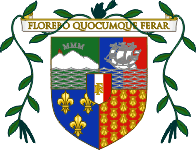
since 1925,
Coat of arms of Réunion,
Source, by: Wikipedia (FR), Superbenjamin,
CC BY-SA 4.0, via Wikimedia Commons
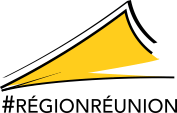
Logo of Réunion,
Source, by: Wikipedia (FR)

The coat of arms of Réunion is a quartered shield which is topped by a smaller shield. Field No. 1 shows in green and white, a coastal landscape with mountains and three letters "MMM", the Roman numeral 3000, which points out to the height of the highest peak of the island. Field No. 2 is splited in blue-red, on it a white ship under full sails. Field No. 3 three shows three golden lilies on blue, the old French Heraldry, a an indication that the island is a French possession since 1649. Field No. 4 is red and is sprinkled with golden bees. The golden bees had been a at Napoléon I. popular token of appreciation, which he has avarded meritorious persons or islands and countries into their coats of arms. An indication that the island was called "Ile Bonaparte" between 1793 and 1814. The heart shield refers to modern France and displays the colours of the French tricolor: blue, white and red, and in the white field the intertwined letters R and F, which stand for "République française". The coat of arms was introduced in 1925 and is the work of Laure Fernando. The inscription above the coat of arms is "Florebo quocumque ferar", what means "I will flourish wherever I will be brought".
Source:
Wikipedia (FR)


Savanna Style Location Map of the Area around 21° 3' 11" S, 55° 19' 30" E
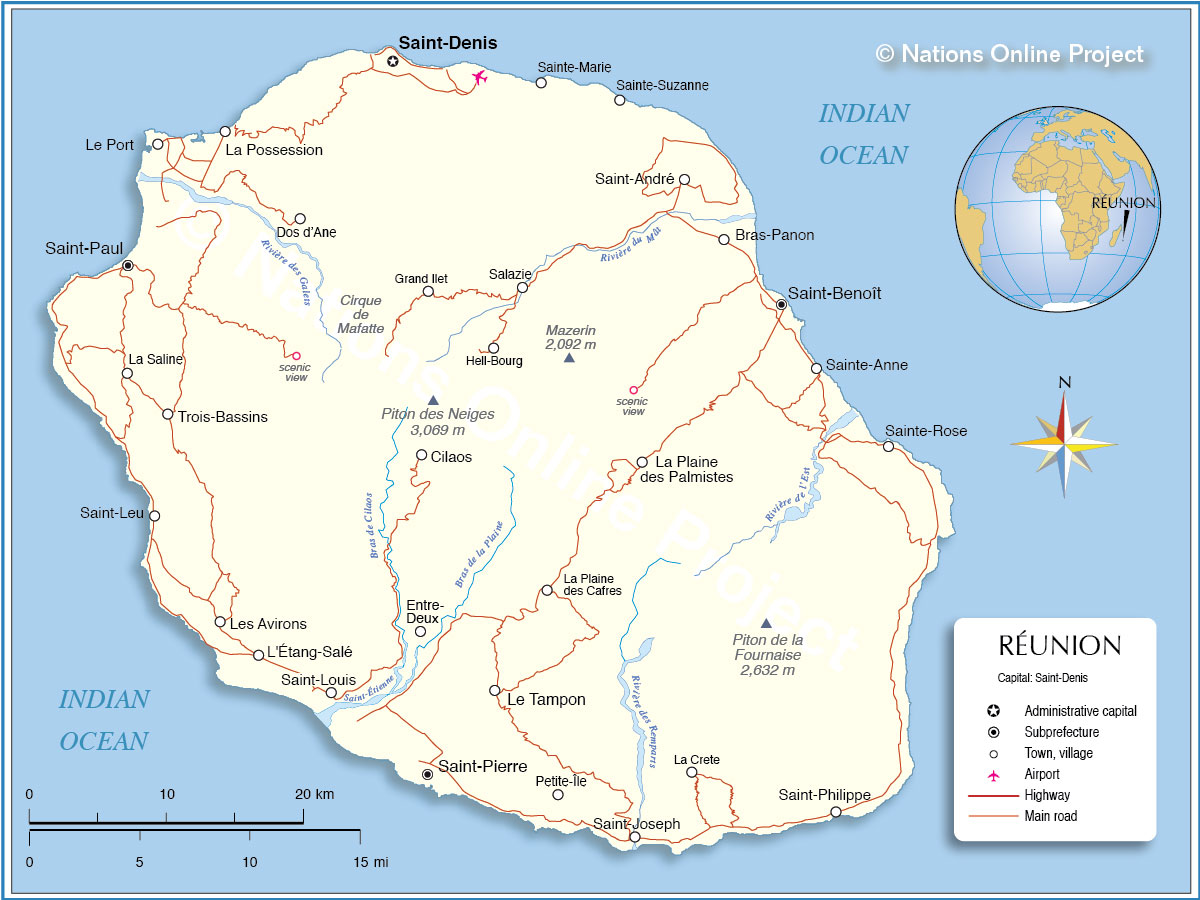
Landkarte/map, Source: www.nationsonline.org,
click to enlarge

Area: 966 square miles
Inhabitants: 855.961 (2018), thereof 45% Africans, 25% Europeans, 25% Indians, 3% Chinese, 1% Arabs
Religions: 86% Roman Catholic, 10% Hindus, Buddhists, Muslims
Density of Population: 886 inh./sq.mi.
Capital: Saint-Denis 150.535 inh. (2018)
official Language: French
other Languages: Creole French
Currency: 1 Euro (€) = 100 Cent
Time Zone: GMT + 4 h
Source:
Wikipedia (D),
Discovery '97

1507 · discovery of the uninhabitet island by the Portuguese navigator Pedro Mascarenhas, he calls the island "Santa Apolonia", a short time later Apolonia, Mauritius and Rodrigues became summarized to the geographical term "Mascarenas"
17th century · the island is a stopover for English and Dutch ships on the sea route to India
1640 · the French debark on the island, they call it "Île Bourbon" (Bourbon Island, the French king comes from the noble House of Bourbon)
1649 · France annexes the island, it becomes a French colony
1665 · beginning French settlement
1793 · rename in "Île de la Réunion"
1802 · reintroduction of slavery by Napoléon I., then the island was renamed in "Ile Bonaparte" to honour him
1810 · British troops occupy the island and give it the old name "Ile Bourbon" back
1848 · abolition of slavery, the island gets back again its old name "Île de la Réunion"
1946 · Réunion is an overseas department
1972 · Frankreich grants limited autonomy
1982 · Réunion is an overseas region
1997 · Réunion is "région ultrapériphérique", an area in outermost regions of the European Union
2005 · the former dependencies of the (Scattered Islands) Îles Éparses become withdrawn from administration of Réunion and subordinated to the manager of the French Southern and Antarctic Lands (TAAF)
2007 · the Scattered Islands (Îles Éparses) become annexed to the French Southern and Antarctic Lands (TAAF)
Source:
Wikipedia (D),
Discovery '97

The Scattered Islands are French possessions and former dependencies of Réunion. They are mainly placed in the west and north of Madagascar. Since 2005, they are managed by the administrator of the colony "French Southern and Antarctic Lands (TAAF)", and in 2007 they became fully annexed to the TAAF.
• Tromelin Island, area: 0,4 sq.mi., inhabitants: ca. 20 (station personnel)
• Europe Island, area: 11 sq.mi., inhabitants: ca. 12 (military and station personnel)
• Bassas da India, area: 0,07 sq.mi., uninhabited
• Juan de Nova, area: 2 sq.mi., inhabitants: ca. 12 (military and station personnel)
• Glorieuses Islands, area: 1,5 sq.mi., inhabitants: ca. 12 (military and station personnel)
Source:
Wikipedia (D)

The island had have a lot of names, so "Santa Apolonia", in honor of St. Apolonia, at whose day Pedro Mascarenhas discovered the island. The French, the first settlers on the island, named it after the dynasty their king "Île Bourbon". Between 1802 and 1810 the island was called "Ile Bonaparte" in honor of Napoléon I. Probably in connection with events of the French Revolution in 1792, the island was renamed in "Île de la Réunion", what means something like "meeting", but it is now forgotten which meeting was actually meant.
Source:
Wikipedia (D)


![]()























